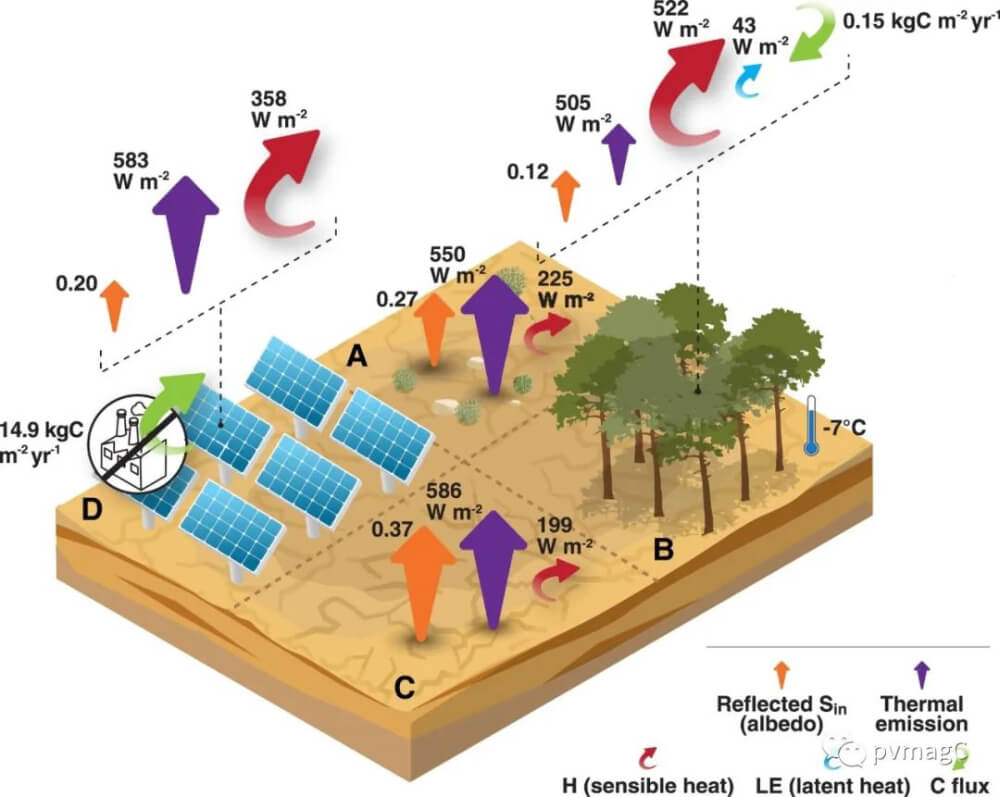New research claims that photovoltaic power generation is superior to afforestation in addressing climate change
 namkoo solar
namkoo solar
Researchers from the Weizmann Institute of Science in Israel compared the effectiveness of ground photovoltaic facilities and afforestation in addressing climate change, and found that the former was superior.
The blackening of land causes climate change, and Israeli scientists have calculated the time required for photovoltaic power plants and afforestation projects to offset the aforementioned warming effects. The calculation results indicate that in arid areas, the carbon reduction efficiency of photovoltaic electric fields may be more than 50 times that of afforestation.

The land conditions will affect the effectiveness of carbon reduction. At noon in summer, arid areas transition from desert to afforestation areas (A, B) and from desert to photovoltaic fields (C, D). Image source: Weizmann Institute of Science, PNAS Nexus, Creative Commons Protocol CC BY 4.0
Scientists have created a new measurement standard in their simulation experiments, which they call "breakeven time" (BET). It calculates the impact of these two technologies on carbon emissions and the time it may take to offset the warming effects caused by land blackening.
"Photovoltaic power generation can significantly reduce anthropogenic carbon emissions. Afforestation can play an important complementary role in efforts to mitigate climate change by providing a direct means of actively removing atmospheric carbon," researchers said. "However, both have a high demand for land area, which may lead to competition for land in forested areas."
In order to determine which land use method is more effective for carbon reduction, scientists conducted a series of measurements in southern Israel. They stated that the dry land here is highly representative. "Dry land accounts for a large portion of the Earth's land surface, nearly half of which are semi-arid areas, which has also attracted attention to potential afforestation projects. However, these dry lands may also be heavily used for the construction of utility scale photovoltaic electric fields," the group explained.
Research findings
Scholars have conducted research on the impact of photovoltaic facilities on surface temperature in a photovoltaic power plant located in a semi-arid area adjacent to Kibbutz Ketura in the Arava Valley of Israel. The photovoltaic field covers an area of 75600 square meters and has an installed capacity of 4.9 MW. Scholars compared the results obtained with background measurements in the same region.
According to their measurements, the sensible heat of the photovoltaic power station is 359 W per square meter. In contrast, the background measurement results of the surrounding area of the power station are 199 W per square meter, with albedos of 0.2 and 0.37, respectively. According to calculations, each square meter of photovoltaic power plant will reduce carbon emissions by 14.9 kilograms per year.
Scientists measured the impact of afforestation on heat levels in the Yatir forest on the northern edge of the Negev Desert in Israel. The forest covers an area of 2800 hectares, with the main tree species being Jerusalem pine. Scientists compared the data collected from here with the data collected from desert backgrounds.
In this example, the measurement results indicate that the sensible heat in the afforestation area is 522 W per square meter, and the sensible heat in the background area is 225 W per square meter. The forest albedo is 0.12, and the desert albedo is 0.27. According to calculations, due to the influence of photosynthesis, the carbon sequestration rate per square meter in this forest area is 0.15 kilograms per year.
"The research results indicate that in arid areas, the carbon reduction efficiency of photovoltaic power stations is more than 50 times that of afforestation," the researchers said. At the same time, they also stated that in arid areas, it takes approximately 1.4 to 3.6 years for photovoltaic power stations to reach balance of income and expenditure, while afforestation takes 94 to 175 years to reach balance of income and expenditure.
Temperate and tropical climates
In addition, researchers also used this method to calculate the balance of income and expenditure time for photovoltaic power plants and afforestation under temperate and tropical climate conditions based on data obtained from previous studies in Germany and Panama. The research findings were published in an article in PNAS Nexus titled "In global climate change mitigation strategies, the carbon reduction efficiency of photovoltaic power plants is significantly better than afforestation.".
They added, "Although the relative efficiency of afforestation has significantly improved compared to photovoltaic power plants in wetter climate conditions, the balance of payments (BET) of photovoltaic power plants is still about 20 times faster than afforestation." They pointed out that under tropical and temperate climate conditions, the BET of photovoltaic power plants is less than one year, while the BET of temperate afforestation is 18.5 years, and that of tropical afforestation is 15.4 years. ".
"The carbon emissions reduced by photovoltaic power generation are much greater than the carbon emissions absorbed by afforestation," they concluded. "However, actively removing past carbon emissions and potentially storing them for long-term use as biomass and soil organic matter is an important advantage of afforestation. Compared to this purely climate perspective, forests provide many other ecological benefits."



































